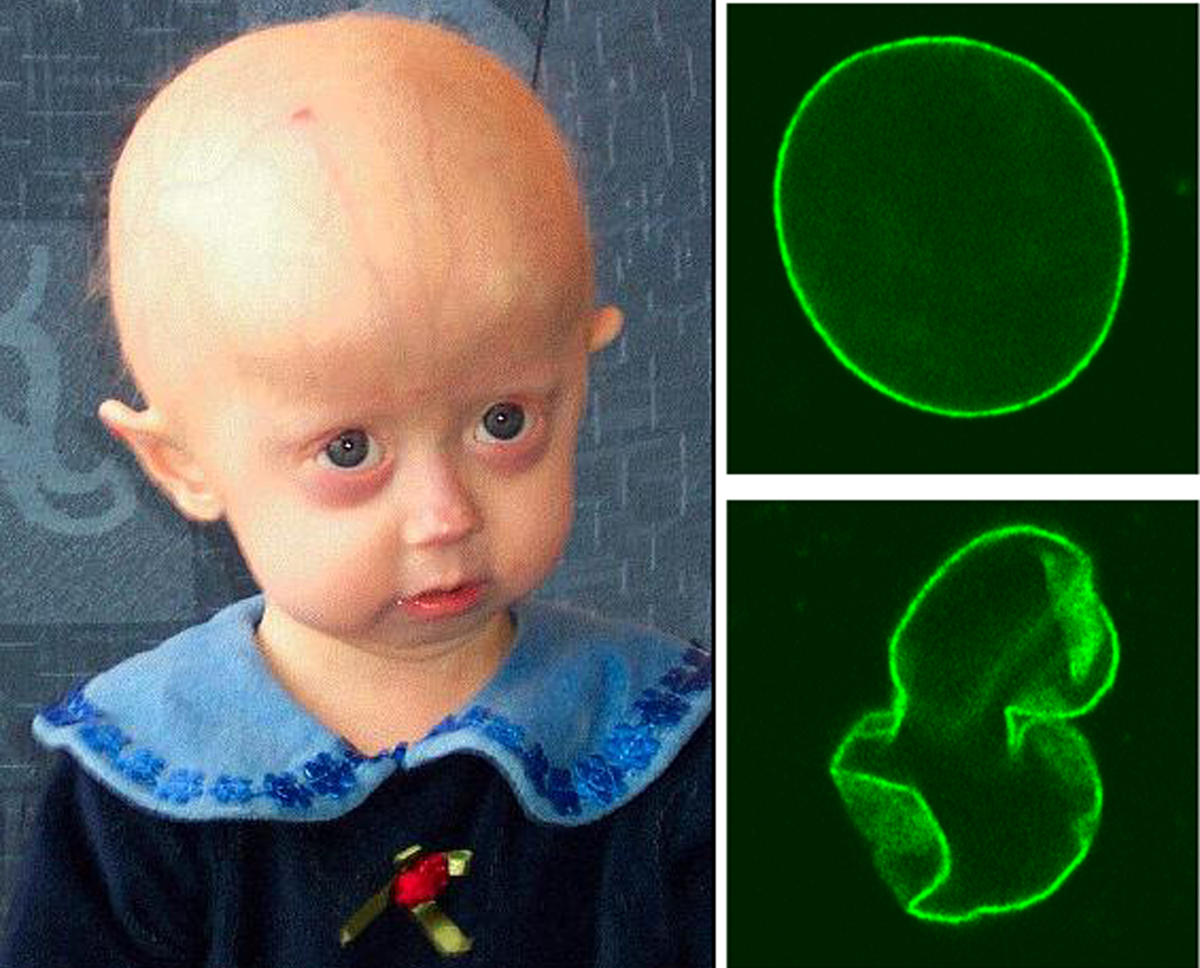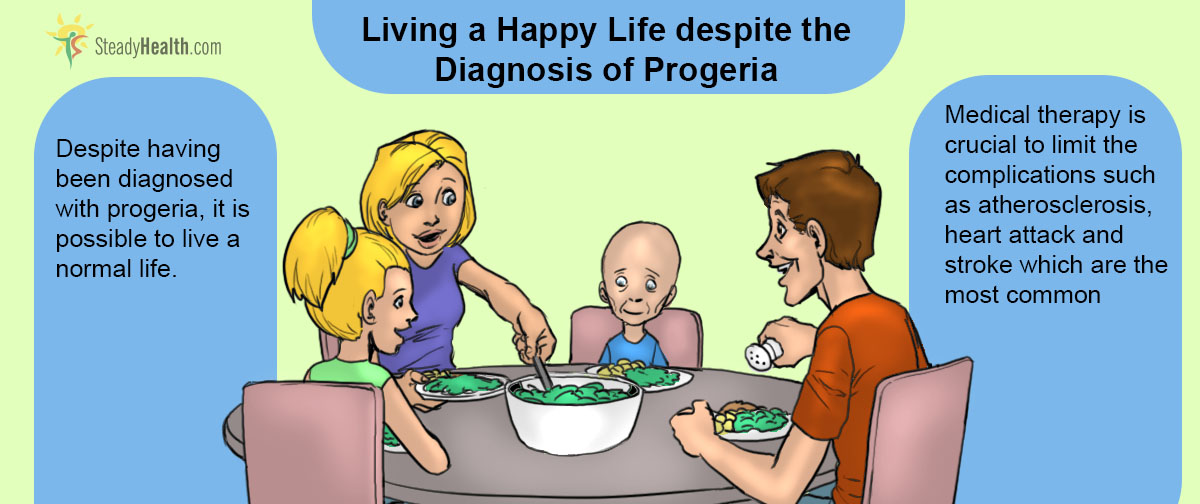Progeria, or Hutchinson–Gilford progeria syndrome, is an extremely rare genetic disorder in which affected children develop 8-10 times faster than the normal rate, leading to premature aging of their cells and characteristic physical features of older people. Progeria was first described in 1886 by Jonathan Hutchinson, and later on in 1897 by Hasting Gilford, giving it the name of Hutchinson – Gilford syndrome. The word “progeria” itself is derived from the Greek words “pro” which means “premature”, “before” and “geria” which is the commonly used prefix for “old age”.
Understanding Progeria
It is believed that progeria is common in 1 in every 4 million births, according to a study made in the Netherlands. On a more global scale, there are currently about 100 known cases of progeria in the known, and possibly 150 undiagnosed cases (but suspected because of characteristic physical features of the disease). In September 2011, was reported the first case of a black child with progeria (South Africa). She was born in 1999 and is currently alive, being monitored for her condition by the Progeria Research Foundation at the Children Hospital, Boston.
What is the Cause of this mysterious disorder?
Before the 20th century, little was known about progeria, particularly its causes and molecular characteristics. Fortunately, increasing researches and interests in this fascinating topics have yielded a lot of results, and today scientists are better able to understand and apprehend the exact mechanism that yields to this condition.
A particular structural protein, lamin A, is needed as an integral part of the cellular lamina. This protein provides support to the nucleus of each cell in our body, and as we know, cells nuclei are the organelles within which the genetic code is contained. When lamin A is not synthesized properly (in a case of alteration in its genetic sequence such as in progeria for example), the proteins that result are extremely short and incomplete, and they provide an abnormal shape to the cellular nuclei. Consequently, because the nucleus of the affected cells (virtually all in the body) is not strong enough, this limits the cells ‘ability to divide during mitosis, thus hindering cellular replication. This is why the cells experience premature aging in progeria.
Symptoms and Characteristics of Progeria
In children with progeria, symptoms almost always develop within the first years of life. The constellation of symptoms include all those related to failure to thrive and developmental delays. Around 1-2 years, these children present with marked failure of achieving developmental milestones. Alongside with that, they present with the typical facial features characteristic of progeria, which include a pinch and beaked nose, narrowed face, prominent eyes, a small face with recessed jaw and finally, a head significantly larger than the body (with prominence of the scalp veins which are even more highlighted by the hair loss).
See Also: How Rare A Rare Disease Can Be?
Because of the speedy rate of cellular turnover and cells aging, children with progeria tend to have a wrinkled skin, and also develop loss of vision, heart problems, kidney problems and liver problems. Atherosclerosis can also be part of the vascular diseases they encounter. The musculoskeletal system is also affected, and children with progeria tend to develop diseases of the elderly such as arthritis, joint stiffness, hip dislocation and increased incidence of bones fractures.
Current Treatment Of Progeria
Today, there is unfortunately no available treatment for cure progeria. Nevertheless, children suffering from this disorder follow some medications regimens to decrease the complications associated with the disease, as they might be a cause of premature death (for example, heart attacks as a result of severe coronary atherosclerosis). With that said, children with progeria benefit from coronary artery bypass procedures (surgical operation where a new connection to supply blood to the heart is created by avoiding the coronary arteries affected by atherosclerosis. Aspirin is also given to them as a prophylactic treatment against heart attacks and other ischemic events. Additionally, those children are put under cholesterol – lowering medicationsto decrease their risk of atherosclerosis, hypertension and coronary artery disease.

Rapamicin is an antibiotic (which belongs to the group of macrolides) thought to reduce the physical features (phenotype) of progeria. It is thought to do so by promoting the breakdown of progerin (abnormal proteins) in affected cells, and reducing the level of nuclear damage in those same cells.
Current Research for Future Treatment
In 2012, it was demonstrated (in a clinical trial) that the anticancer drug Lonafarnib is capable of stimulating weight gain in children with progeria.
Prognosis
On average, the life expectancy of children suffering from progeria is 13 years. The most common cause of death in those children is complications from atherosclerotic disease (heart attacks, stroke). This explains why the main goal of therapeutic intervention when dealing with this disease is limiting the symptoms and life-threatening complications. Also, even though these children experience developmental problems, it has been shown (through research and even experience) that their intellect is not affected and they do not present with any kind of mental retardation. Also, their excessive rate of cellular turnover does not predispose them to cancer as others could have believed.
Notable Cases in Popular Culture
See Also: The most common childhood diseases
And we can safely say that because of them, researchers’ interest has been exponentially triggered to discover more about this unfortunate disorder.
One of the most recent cases of progeria (and probably the most known in this generation) is the case of the late Sam Berns, a teenager from Massachusetts who died on January 10th, 2014 (age 17) of the disease. He made several TV appearances which helped to raise public awareness of the disorder. He was known for his courage, undying enthusiasm and for being full of life. In one of his interviews, he proudly declared having had a happy life. Another well-known person suffering from progeria is Hayley Okines, which also helped to raise public awareness regarding this disorder. One of the longest survivor of progeria was the South African hip hop artist Leon Botha who passed away on May 26th, 1985. He was 29 years old. Meg Casey, a spokesperson for the handicapped, also survived this disorder for 26 years.
- Mindmap by steadyhealth.com
- upload.wikimedia.org/wikipedia/commons/6/6e/Hutchinson-Gilford_Progeria_Syndrome.png



Your thoughts on this